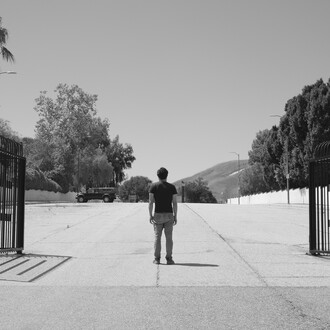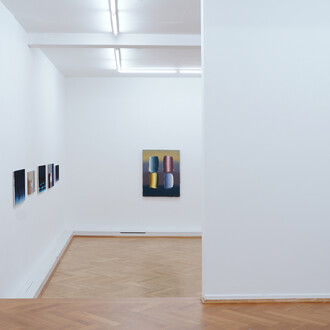Tempora Showa by Inna Levinson marks the artist's first solo exhibition with Circle Culture. Her paintings are the result of an intensive investigation of our reality that is shaped by new technologies. In her works, the artist uses fragmentary references to digital phenomena, scientific knowledge and philosophical perspectives in order to question the substance of reality in the age of digital transformation.
Characteristic of Levinson's works is a grid-like structure, which results from the interplay of the paint and the surface of the canvas. In varying degrees of opacity, she applies oil paint with a palette knife on coarse jute fabric, keeping the texture of the canvas visible that thereby becomes an essential part of the image. The resulting works have a pointilist look and alternate between abstract shapes and vague or distorted human figures. The exhibition is comprised of paintings that deal with the influence of the digital on our perception.
The work SE//90/75/W /G/BL/2017 focuses on a subject that is popular on social media channels: the work shows a figure who takes a self-portrait with his/her smartphone. The artist has reduced the image to a few key elements. Hands and telephone materialize themselves in the foreground from pasty paint, while the face is barely recognizable. In the diptych D//SE/90/150/W/G/RO/2017, the hands and mobile phones are depicted in reduced forms and scaled to various dimensions, superimposing to a kaleidoscope-like view. The self-portrait has a long tradition in art in the mediums of painting and photography––with the smartphone selfie it has become an ephemeral mass phenomenon. In Levinson's works, these portraits turn into stereotypical and unidentifiable, repetitive images. The topic of hands holding a smartphone is also the starting point of the work SE//180/150/R/G/B/W/2018. Levinson has reduced the gesture to the outlines and scaled it up to a monumental object that enters into competition with the human silhouette. The painting references the user interface of a digital image-editing program in which the hands have been cropped from their context, duplicated and blown up to a larger-than-life size. Levinson translates the aesthetics of computer desktops with their various windows layering over each other into collage-like compositions. Often, the works are characterized by a perspective that mimics the point of view that one takes in regard to a screen. By transferring the digital images into her works, she also places them in direct contrast to traditional subjects of painting, such as landscapes. In Levinson's works, the view out of a window on the world is replaced by the view on a monitor, which levels body, space and perspective to a two-dimensional surface, ignoring proportions and making everything equally present.
The large-format painting E//200/300/M/GR/R/2018 shows the back of a muscular male body that seems to be cropped to fit into a rectangular frame, lacking legs and the left hand. The artist uses the giant body to address the possibilities of manipulation through digital image processing and the resulting distorted body images. In the second major work, E//200/300/W/GR/2018, an isolated leg in a high-heeled shoe moves acrobatically across the entire pictorial space. These works show almost surreal scenes, yet they derive directly from the conventions of digital imagery.
A recurring theme in Inna Levinson's works are schematic depictions of the earth elements. By presenting these materials, the artist refers to the Five Element theory, which deals with energies that influence human beings and shape the material things on earth. In addition to the Five Elements as a reference to the attempt to describe reality, her works also contain parts that mimic molecular structures and thus focus on the scientific explanation of the natural world. By condensing the technical, medial, social, cultural and biochemical framework that shapes our reality, Levinson measures our contemporary time, which is rapidly and steadily changing with technological developments.
Inna Levinson (* 1984) studied Fine Arts at the University of the Arts (UdK) Berlin. She lives and works in Berlin.
















